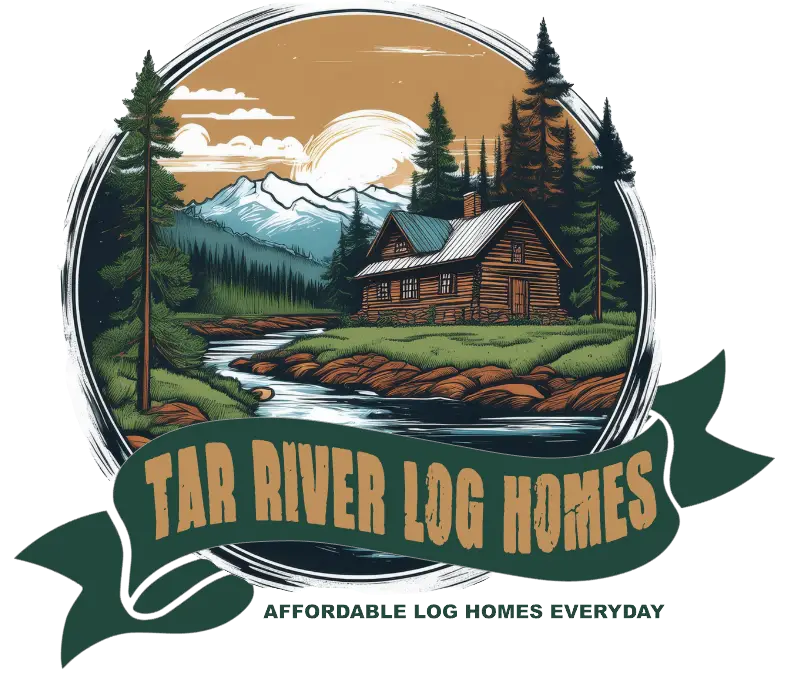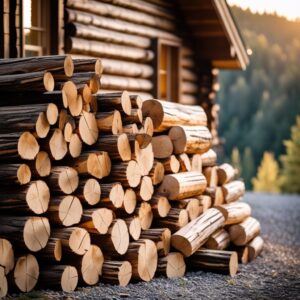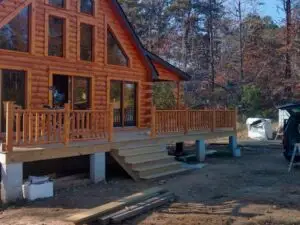Building a cabin is about more than stacking wood. The quality of your logs determines how solid, efficient, and long-lasting your home will be.
Kiln-dried logs take the guesswork out of the process. By drying the wood in a controlled environment, moisture levels drop to the right range. This way, you get stronger logs that won’t twist, warp, or attract pests.
At Tar River Log Homes, we believe families deserve dependable materials without inflated costs. That’s why we supply kiln-dried logs at wholesale prices—straightforward, no hidden fees. Choosing kiln-dried logs means fewer surprises after construction. Your cabin stays tighter, cleaner, and easier to maintain.
This guide explains how kiln drying works, why it matters, and how it can save you money and effort for years to come.
What Are Kiln-dried Logs?
Kiln-dried logs are wood dried in a big oven, called a kiln, to get rid of moisture. This process makes the logs stronger, less likely to shrink, and just plain easier to work with than fresh or air-dried wood. Understanding how Kiln-dried logs work and compare to other options helps decide if they’re right for your cabin.
How Kiln Drying Works
Kiln drying uses heat and controlled airflow to dry logs way faster and more evenly than just leaving them outside. Logs go into a large kiln where temperature, humidity, and airflow get dialed in. Depending on the wood and its size, drying can take a few days up to a couple of weeks.
The main goal? Get the moisture content down to about 18% or less. That’s low enough to cut back on mold, rot, and pests. Kiln drying also wipes out bugs hiding in the wood, so your logs arrive clean and ready.
Differences Between Kiln-dried and Seasoned Logs
Seasoned logs just sit and dry in the open air for months—or even years. It’s slower, and results can be hit or miss. Seasoned logs usually have more moisture, often 20-30%, while Kiln-dried logs come in lower, usually under 18%.
Because Kiln-dried logs dry in a controlled space, they keep their shape better and don’t crack or warp as much. That’s a big plus when you’re building.
| Feature | Kiln-dried Logs | Seasoned Logs |
| Drying Speed | Days to weeks | Months to years |
| Moisture Content | About 18% or less | 20%-30% or more |
| Pest Risk | Low (pests killed) | Higher |
| Stability | High (less warping) | Lower |
Benefits of the Kiln Drying Process
Kiln-dried logs save you time—they’re ready to use right away, so you can start building faster instead of waiting for wood to dry. Logs with low moisture last longer and resist rot and insects.
Less shrinkage means fewer gaps and headaches later. Some suppliers offer kiln-dried logs ready to go, shipped directly to your build site. You get logs that fit your plans and help you dodge common building hassles.
Why Use Kiln-dried Logs in Cabins?
Kiln-dried logs make a real difference in how your cabin feels and lasts. They help keep your space cozy, use less energy to heat and cool, and even improve the air inside. Plus, these logs hold up better over the years.
Enhanced Energy Efficiency
Since Kiln-dried logs have less moisture, they don’t shrink or swell much after you build. That means your cabin stays tight against drafts. Dry wood also insulates better. You’ll probably notice lower heating bills in winter and less need for AC in summer. That’s more money in your pocket.
Using kiln-dried logs helps you save without sacrificing warmth or comfort. Less movement in the logs means fewer cracks for air to sneak through.
Improved Indoor Air Quality
Wet logs can trap mold, dust, and bugs—never fun, especially if you have allergies.
Kiln drying knocks out most insects and keeps mold from starting. It also cuts down on sticky resin, so you won’t get weird smells or build-up.
With Kiln-dried logs, your cabin just feels cleaner. You get to enjoy your space, not fret about what’s lurking in the walls.
Durability and Longevity
Kiln-dried logs are just tougher. Less moisture means less chance for rot or decay. Your cabin walls and roof hold up better to the elements.
Fewer cracks and splits mean less maintenance down the road. The wood stays strong and keeps its shape for years.
Kiln-dried logs really do stand up to weather and pests, keeping cabins safe and sturdy. Your cabin stays safe, sturdy, and comfortable.
Selecting the Best Kiln-dried Logs for Your Cabin
Picking the right Kiln-dried logs means thinking about wood type, log size, and moisture level. These details make sure your cabin is built to last and stays dry.
Choosing the Right Wood Species
The type of wood you choose matters. Different woods handle weather and wear differently, and they each have their own look. Eastern White Pine is a favorite for cabins—it’s light, easy to work with, and dries well. Plus, it resists shrinking and cracking.
Hardwoods like oak or maple are tougher, but they’re pricier and heavier. If you want a classic cabin vibe and good insulation, pine or cedar are both solid picks. Trusted companies focus on affordable wood that won’t break the bank.
Pick wood that fits your climate and your wallet. Pine is a great choice for most folks—good value, and it lasts.
Log Size and Dimensions
Logs come in all sizes, and your choice affects strength and insulation. Bigger logs keep things warmer in winter but cost more and take longer to prep.
Smaller logs are easier to handle and cheaper, though you might need extra insulation. Most logs are 8 to 12 inches in diameter, and lengths run 16 to 20 feet, depending on your cabin design.
Decide on log size based on your climate and how much work you want. The right supplier can help you find the best fit for your plans and budget.
Moisture Content Considerations
Moisture content is huge for log quality. Kiln drying brings it down to about 18% or less. Logs with too much moisture will shrink, crack, or grow mold after you build.
Make sure your logs are tested and certified Kiln-dried. That means they were dried slowly and evenly, so you don’t get hidden wet spots. If the moisture isn’t right, you’ll end up with gaps or warping. Keeping it low means fewer repairs and a stronger cabin.
Preparing and Storing Kiln-dried Logs
Protecting Kiln-dried logs before you build is important. Good storage and handling keep your wood dry and strong, so your cabin lasts longer.
Proper Storage Techniques
Store your Kiln-dried logs with space for air to move around. Don’t put them straight on the ground—use pallets, blocks, or something flat to keep moisture out.
Cover logs with a breathable tarp or roof to shield from rain and snow, but don’t wrap them tight in plastic. That can trap moisture and cause problems.
Keep your stack out of direct sunlight. Too much sun can dry the wood too fast and cause cracks. A shaded spot, like a shed or lean-to, is ideal.
Stacking and Handling Tips
Stack logs in neat rows with some space between each for air flow. Use stickers—little strips of wood between layers—to help with drying. Put heavier logs at the bottom so the stack doesn’t tip or bend the ones on top. Move logs gently to avoid dents or cracks.
Treat each log with care. Good stacking and handling protect your investment and make building your cabin smoother.
Tips for Building Cabins with Kiln-dried Logs
Building with Kiln-dried logs gives you stronger, drier wood that shrinks less and stands up to pests. To keep your cabin solid and comfortable, pay attention to how you install, seal, and care for the logs.
Installation Best Practices
Check each log for cracks or damage before you install. Use a moisture meter to double-check they’re dry—shoot for below 12%. Dry logs fit better and don’t shrink as much later. Stack logs tightly and use stainless steel spikes or screws to secure them.
Skip the nails—they loosen over time. Make sure every log is level and lined up to avoid gaps. Use tools like a log scribe or chisel to fit corners snugly. For corners, saddle or dovetail notches work best for stability. Stick to your build plan for a smoother process.
Insulation and Sealing Methods
Even Kiln-dried logs need sealing to keep out drafts and moisture. Use good, flexible chinking or caulking made for log homes. Apply it evenly between logs to stop air leaks. Add insulation around windows, doors, and the roof where gaps can sneak in.
Foam tape or spray foam can help without hurting the wood. A breathable sealant finish protects from moisture but lets logs breathe. Avoid anything that traps moisture—it can lead to rot.
Log Maintenance Recommendations
Check your logs at least once a year for cracks, bugs, or wet spots. Catching issues early means less hassle later. Clean logs with a soft brush and mild soap—no high-pressure washers, those can wreck the surface and strip finishes.
Apply a UV-resistant stain or sealant every 3 – 5 years to protect from sun damage. Use products made for kiln-dried logs to keep your cabin looking sharp. Keep bushes and trees trimmed back to stop moisture and pests from getting too close. A little maintenance goes a long way for a safe, comfy cabin.
Sourcing and Purchasing Kiln-dried Logs
Finding the right Kiln-dried logs is all about knowing where to look, what to ask, and what drives the price. You want reliable suppliers with quality logs and clear, honest pricing.
Finding Reliable Suppliers
Look for suppliers who focus on Kiln-dried logs for cabins. Good reviews and real experience matter—skip the ones who only cater to luxury projects. Ask about their drying process and how long they kiln-dry the logs. That affects shrinkage and cracking down the line.
Some suppliers offer top-quality logs at wholesale prices, with no hidden fees. Check if the supplier offers help or advice as you buy. The best ones want you to get the right logs, not just make a sale.
Evaluating Quality and Certifications
Good Kiln-dried logs should have less than 20% moisture. Ask for test reports or certificates if you want proof. Look for logs graded for structural use. These meet the strength and durability standards needed for cabins.
See if the supplier has certifications like the Forest Stewardship Council (FSC) or other sustainable forestry marks. That means the wood was harvested responsibly. Check the logs for cracks, knots, or warping. Quality logs are straight and well-cut, which makes building easier.
Cost Factors to Consider
Kiln-dried logs cost more than green logs up front, but they save you money over time by reducing warping and shrinking. Prices depend on wood species, log size, and drying quality. Eastern White Pine is common and affordable for cabins.
Watch for extra charges like delivery, cutting, or packaging when comparing prices. Some suppliers even offer a price guarantee, giving you peace of mind on cost. Buying direct from the supplier skips the middleman and usually means better prices for you.
Environmental Impacts of Kiln-dried Logs
Kiln drying wood changes the logs in ways that really shape their environmental footprint. It starts with forest management—ideally, the kind that keeps forests healthy and reduces waste during shipping and building. If you care about making a better choice for your cabin, it’s worth considering how these logs are sourced and treated.
Sustainable Forestry Practices
Most Kiln-dried logs come from forests managed for regrowth and long-term health. Harvesters cut trees in a way that doesn’t wreck the forest’s future. You can feel pretty good knowing the wood likely comes from places where new trees get planted regularly.
Sourcing wood this way helps protect animal habitats and keeps water cleaner. Fewer trees get cut down overall, which just makes sense. When you pick Kiln-dried logs from responsible forestry practices, you’re backing forests that can keep going strong.
Reduced Environmental Footprint
Kiln drying drops the moisture in logs to about 18% or lower. That makes the wood lighter, sturdier, and less likely to attract mold or bugs—no chemicals needed. Plus, drier logs mean your cabin won’t need as much upkeep down the road.
Because they’re lighter and take up less space, it takes less fuel to ship them. That means less energy burned and less pollution. Choosing kiln-dried logs from responsible forestry practices means you get wood that’s tough, reliable, and easier on the environment.
Common Mistakes to Avoid with Kiln-dried Logs in Cabins
Don’t skip checking the moisture content before building. Even Kiln-dried logs can sometimes hold more moisture than you’d expect, and that can lead to warping or cracks later.
People sometimes rush the settling process, too. Even Kiln-dried logs need time to adjust after you build. If you move too fast, you might end up with gaps or misaligned walls as the wood shifts.
Leaving logs outside without good cover is a recipe for problems. Rain or snow can soak in and undo all that careful drying. Keep them under a roof or at least a tarp until you’re ready to use them.
It’s easy to pick the wrong sealant or finish, but some products actually trap moisture and cause rot. Stick with finishes made for Kiln-dried wood.
Build Smarter with Kiln-dried Logs
Kiln-dried logs give your cabin strength, durability, and comfort from the start. With less moisture, they resist pests, mold, and cracking—keeping your home tight and reliable for years.
Investing in quality logs now saves you time, money, and repairs later. The right materials make building smoother and living easier. At Tar River Log Homes, we keep it simple—affordable kiln-dried logs, fair pricing, and honest support for your project.
Ready to plan your cabin the smart way? Contact us and get started with kiln-dried logs you can count on.
Frequently Asked Questions
Kiln-dried logs come with a bunch of perks for cabins: they’re easier to work with, shrink less, and don’t attract pests as much. You’ll probably want to know about availability, costs, how long they last, and the best wood types before you make up your mind.
Where can I purchase Kiln-dried logs for my cabin in Canada?
You can get Kiln-dried logs from local sawmills or specialty suppliers. Some U.S. suppliers deliver kiln-dried logs to Canadian customers, making it easier to source quality materials.
How do Kiln-dried logs compare in price with other types of firewood?
They tend to cost more upfront than green or air-dried wood. But since they burn cleaner and light up faster, you might save money over time. For building, they’re pricier, but you won’t have to wait around for them to dry.
What are the benefits of using Kiln-dried logs for building a cabin?
Kiln drying pulls out most of the moisture, so you don’t have to worry as much about warping, cracking, or shrinking. Your cabin will stay tighter and sturdier for longer. Drier logs also keep mold and bugs at bay.
Are there any drawbacks to using Kiln-dried wood for construction?
The main downside is the higher price tag. Kiln-dried logs can also be a bit more brittle, so you have to handle them with some care to avoid splits. Still, the stability and durability usually make up for those issues.
How long can I expect my Kiln-dried logs to last once purchased?
If you take care of them—keep your cabin sealed and painted—Kiln-dried logs can last for decades. Protecting the wood from weather and pests goes a long way in making sure your cabin stands the test of time.
Which type of wood is optimal for the construction of a log cabin?
Eastern White Pine pops up a lot when folks talk about building cabins. It’s easy to cut, doesn’t twist around much, and you can get it as kiln-dried logs—makes life easier. Many suppliers offer this wood at wholesale prices, which is appealing if you’re watching your budget.




